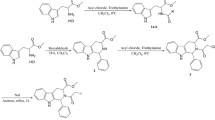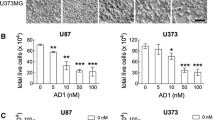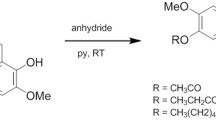Abstract
Colchicine, an antimitotic alkaloid isolated from Colchicum autumnale, is a classical drug for treatment of gout and familial Mediterranean fever. It causes antiproliferative effects through the inhibition of microtubule formation, which leads to mitotic arrest and cell death by apoptosis. Here, we report that a novel colchicine analog, 4o (N-[(7S)-1,2,3-trimethoxy-9-oxo-10-[3-(trifluoromethyl)-4-chlorophenylamino]-5,6,7,9-tetrahydrobenzo[a]heptalen-7-yl]acetamide), which exhibited potent anticancer activities both in vitro and in vivo. In this study, 4o with excellent pharmacokinetic profile and no P-gp induction liability displayed strong inhibition of proliferation against various human cancer cell lines. However, pancreatic cancer cell line MIA PaCa-2 was found to be more sensitive towards 4o and showed strong inhibition in concentration and time-dependent manner. By increasing intracellular reactive oxygen species (ROS) levels, 4o induced endoplasmic reticular stress and mitochondrial dysfunction in MIA PaCa-2 cells. Blockage of ROS production reversed 4o-induced endoplasmic reticulum (ER) stress, calcium release, and cell death. More importantly, it revealed that increased ROS generation might be an effective strategy in treating human pancreatic cancer. Further 4o treatment induced mitotic arrest, altered the expression of cell cycle-associated proteins, and disrupted the microtubules in MIA PaCa-2 cells. 4o treatment caused loss of mitochondrial membrane potential, cytochrome c release, upregulation of Bax, downregulation of Bcl-2, and cleavage of caspase-3, thereby showing activation of mitochondrial mediated apoptosis. The in vivo anticancer activity of the compound was studied using sarcoma-180 (ascitic) and leukemia (P388 lymphocytic and L1210 lymphoid) models in mice and showed promising antitumor activity with the least toxicity unlike colchicine. Such studies have hitherto not been reported. Taken together, these findings highlighted that 4o, a potent derivative of colchicine, causes tumor regression with reduced toxicity and provides a novel anticancer candidate for the therapeutic use.










Similar content being viewed by others
References
Schlesinger N, Schumacher R, Catton M, Maxwell L. Colchicine for acute gout. Cochrane Database Syst Rev. 2006;4:CD006190.
Lidar M, Livneh A. Familial Mediterranean fever: clinical, molecular and management advancements. Neth J Med. 2007;65:318–24.
Lee SH, Park SK, Kim JM, Kim MH, Kim KH, Chun KW, et al. New synthetic thiocolchicine derivatives as low toxic anticancer agents. Arch Pharm. 2005;338:582–9.
Tozer GM, Kanthou C, Parkins CS, Hill SA. The biology of the combretastatins as tumour vascular targeting agents. Int J Exp Pathol. 2008;83:21–38.
Singh B, Kumar A, Joshi P, Guru S, Kumar S, Wani ZA, Mahajan G, et al. Colchicine derivatives with potent anticancer activity and reduced P-glycoprotein induction liability. Org Biomol Chem. 2015;13:5674–89.
Jemal A, Siegel R, Xu J, Ward E. Cancer statistics. CA Cancer J Clin. 2010;60:277–300.
Bardeesy N, DePinho RA. Pancreatic cancer biology and genetics. Nat Rev Cancer. 2002;2:897–909.
Kim SH, Choi KC. Anti-cancer effect and underlying mechanism(s) of kaempferol, a phytoestrogen, on the regulation of apoptosis in diverse cancer cell models. Toxicol Res. 2013;29:229–34.
Cao A, Li Q, Yin P, et al. Curcumin induces apoptosis in human gastric carcinoma AGS cells and colon carcinoma HT-29 cells through mitochondrial dysfunction and endoplasmic reticulum stress. Apoptosis. 2013;11:1391–402.
Todd DJ, Lee AH, Glimcher LH. The endoplasmic reticulum stress response in immunity and autoimmunity. Nat Rev Immunol. 2008;8:663–74.
Orlach AG, Klappa P, Kietzmann T. The endoplasmic reticulum: folding, calcium homeostasis, signaling, and redox control. Antioxid Redox Signal. 2006;8:1391–418.
Rajan SS, Srinivasan V, Balasubramanyam M, et al. Endoplasmic reticulum (ER) stress & diabetes. Indian J Med Res. 2007;125:411–24.
Schroder M. Endoplasmic reticulum stress responses. Cell Mol Life Sci. 2008;65:862–94.
Ager RJ, Bertrand MJ, Gorman AM, et al. The unfolded protein response at the crossroads of cellular life and death during endoplasmic reticulum stress. Biol Cell. 2012;104:259–70.
Kim H, Tu HC, Ren D, et al. Stepwise activation of BAX and BAK by tBID, BIM, and PUMA initiates mitochondrial apoptosis. Mol Cell. 2009;36:487–99.
Kumar A, Singh B, Sharma PR, Bharate SB, Saxena AK, Mondhe DM. A novel microtubule depolymerizing colchicine analogue triggers apoptosis and autophagy in HCT-116 colon cancer cells. Cell Biochem Funct. 2016;34:69–81.
Zhang H, Li H, Yang L, Deng Z, Luo H, Ye D, Bai Z, Zhu L, Ye W, Wang L, Chen L. The ClC-3 chloride channel associated with microtubules is a target of paclitaxel in its induced-apoptosis. Sci Report. 2013;3:15.
Dai J, Wang J, Li F, Ji Z, Ren T, Song Q. Scutellaria barbate extract induces apoptosis of hepatoma H22 cells via the mitochondrial pathway involving caspase-3. World J Gastroenterol. 2008;14:7321–8.
Chen T, Pengetnze Y, Taylor C. Src inhibition enhances paclitaxel cytotoxicity in ovarian cancer cells by caspase-9-independent activation of caspase-3. Mol Cancer Ther. 2005;2:217–24.
Rello S, Stockert JC, Moreno V, Gámez A, Pacheco M, Juarranz A, Cañete M, Villanueva A. Morphological criteria to distinguish cell death induced by apoptotic and necrotic treatments. Apoptosis. 2005;10:201–8.
Koppikar SJ, Choudhari AS, Suryavanshi SA, Kumari S, Chattopadhyay S, et al. Aqueous cinnamon extract (ACE-c) from the bark of Cinnamomum cassia causes apoptosis in human cervical cancer cell line (SiHa) through loss of mitochondrial membrane potential. BMC Cancer. 2010;10:210.
Geran RI, Greenberg NH, MacDonald MM, et al. Protocol for screening chemical agents and natural products against animal tumors and other biological systems. Cancer Chemother Rep. 1972;3:1–103.
Jordan MA, Wilson L. Microtubules as a target for anticancer drugs. Nat Rev Cancer. 2004;4:253–65.
Jackson JR, Patrick DR, Dar MM, Huang PS. Targeted anti-mitotic therapies: can we improve on tubulin agents. Nat Rev Cancer. 2007;7:107–17.
Call JA, Eckhardt SG, Camidge DR. Targeted manipulation of apoptosis in cancer treatment. Lancet Oncol. 2011;9:1002–11.
Kastan MB, Bartek J. Cell-cycle checkpoints and cancer. Nature. 2004;432:316–23.
Vermeulen K, Van Bockstaele DR, Berneman ZN. The cell cycle: a review of regulation, deregulation and therapeutic targets in cancer. Cell Prolif. 2003;36:131–49.
Hanahan D, Weinberg RA. Hallmarks of cancer: the next generation. Cell. 2011;144:646–74.
Satyanarayana A, Kaldis P. Mammalian cell-cycle regulation: several Cdks, numerous cyclins and diverse compensatory mechanisms. Oncogene. 2009;28:2925–39.
Liu ZL, Tian W, Wang Y, Kuang S, Luo X, Yu Q. A novel sulfonamide agent, MPSP-001, exhibits potent activity against human cancer cells in vitro through disruption of microtubule. Acta Pharmacol Sin. 2012;33:261–70.
Szatrowski TP, Nathan CF. Production of large amounts of hydrogen peroxide by human tumor cells. Cancer Res. 1991;51:794–8.
Trachootham D, Alexandre J, Huang P. Targeting cancer cells by ROS-mediated mechanisms: a radical therapeutic approach. Nat Rev Drug Discov. 2009;8:579–91.
Gorrini C, Harris IS, Mak TW. Modulation of oxidative stress as an anticancer strategy. Nat Rev Drug Discov. 2013;12:931–47.
Alexandre J, Hu Y, Lu W, Pelicano H, Huang P. Novel action of paclitaxel against cancer cells: bystander effect mediated by reactive oxygen species. Cancer Res. 2007;67:3512–7.
Leber B, Lin L, Andrews DW. Embedded together: the life and death consequences of interaction of the Bcl-2 family with membranes. Apoptosis. 2007;12:897–911.
Rizzuto R, Pozzan T. Microdomains of intracellular Ca2+: molecular determinants and functional consequences. Physiol Rev. 2006;86:369–408.
Hellebrand EE, Varbiro G. Development of mitochondrial permeability transition inhibitory agents: a novel drug target. Drug Discov Ther. 2010;4:54–61.
Tomasello F, Messina A, Lartigue L, et al. Outer membrane VDAC1 controls permeability transition of the inner mitochondrial membrane in cellulo during stress-induced apoptosis. Cell Res. 2009;19:1363–76.
Orrenius S. Mitochondrial regulation of apoptotic cell death. Toxicol Lett. 2004;149:19–23.
Ling YH, Lin R, Perez-Soler R. Erlotinib induces mitochondrial-mediated apoptosis in human H3255 non-small-cell lung cancer cells with epidermal growth factor receptorL858R mutation through mitochondrial oxidative phosphorylation-dependent activation of BAX and BAK. Mol Pharmacol. 2008;74:793–06.
Kirkin V, Joos S, Zörnig M. The role of Bcl-2 family members in tumorigenesis. Biochim Biophys Acta. 2004;1644:229–49.
Yip KW, Reed JC. Bcl-2 family proteins and cancer. Oncogene. 2008;27:6398–406.
Kroemer G, Reed JC. Mitochondrial control of cell death. Nat Med. 2000;6:513–9.
Hengartner MO. The biochemistry of apoptosis. Nature. 2000;407:770–6.
Paris C, Bertoglio J, Breard J. Lysosomal and mitochondrial pathways in miltefosine-induced apoptosis in U937 cells. Apoptosis. 2007;12:1257–67.
Acknowledgments
We thank our Director Dr. Ram A. Vishwakarma for encouraging us to complete this work. Ashok Kumar is thankful to the Department of Science and Technology, Government of India, for INSPIRE fellowship.
Author information
Authors and Affiliations
Corresponding authors
Ethics declarations
Conflicts of interest
None.
Additional information
IIIM publication number IIIM/1880/2016
Rights and permissions
About this article
Cite this article
Kumar, A., Singh, B., Mahajan, G. et al. A novel colchicine-based microtubule inhibitor exhibits potent antitumor activity by inducing mitochondrial mediated apoptosis in MIA PaCa-2 pancreatic cancer cells. Tumor Biol. 37, 13121–13136 (2016). https://doi.org/10.1007/s13277-016-5160-5
Received:
Accepted:
Published:
Issue Date:
DOI: https://doi.org/10.1007/s13277-016-5160-5




